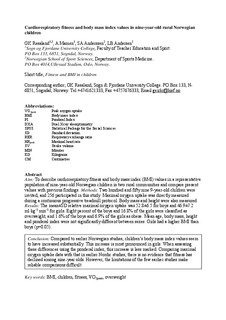Cardiorespiratory fitness and body mass index values in 9-year-old rural Norwegian children
Journal article, Peer reviewed
Permanent lenke
http://hdl.handle.net/11250/149299Utgivelsesdato
2009-01-07Metadata
Vis full innførselSamlinger
Originalversjon
Acta Paediatrica. 2009, 98(4), 687-692Sammendrag
Aim: To describe cardiorespiratory fitness and body mass index (BMI) values in a representative population of 9-year-old Norwegian children in two rural communities and compare present values with previous findings. Methods: Two hundred and fifty-nine 9-year-old children were invited, and 256 participated in this study. Maximal oxygen uptake was directly measured during a continuous progressive treadmill protocol. Body mass and height were also measured. Results: The mean ± SD relative maximal oxygen uptake was 52.8 ± 6.5 for boys and 46.9 ± 7.2 mL/kg/min for girls. Eight percent of the boys and 16.8% of the girls were classified as overweight, and 1.6% of the boys and 6.9% of the girls as obese. Mean age, body mass, height and Ponderal index were not significantly different between sexes. Girls had a higher BMI than boys (p = 0.05). Conclusion: Compared to earlier Norwegian studies, children's BMI values seem to have increased substantially. This increase is most pronounced in girls. When assessing these differences using the PI, this increase is less marked. Comparing maximal oxygen uptake data with that in earlier Nordic studies, there is no evidence that fitness has declined among 9-year olds. However, the limitations of the few earlier studies make reliable comparisons difficult.
Beskrivelse
I Brage finner du siste tekst-versjon av artikkelen, og den kan inneholde ubetydelige forskjeller fra forlagets pdf-versjon. Forlagets pdf-versjon finner du på www.interscience.wiley.com: http://dx.doi.org/10.1111/j.1651- 2227.2008.01181.x / In Brage you'll find the final text version of the article, and it may contain insignificant differences from the journal's pdf version. The original publication is available at www.interscience.wiley.com: http://dx.doi.org/10.1111/j.1651- 2227.2008.01181.x
